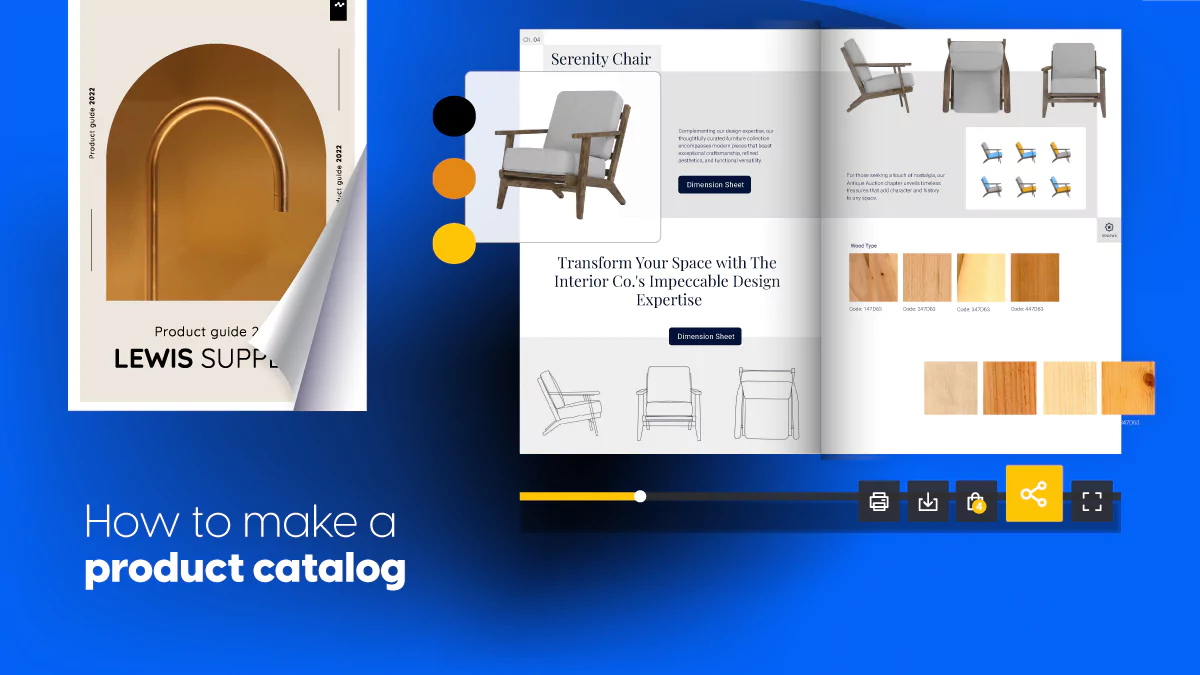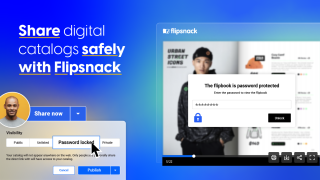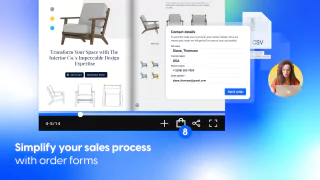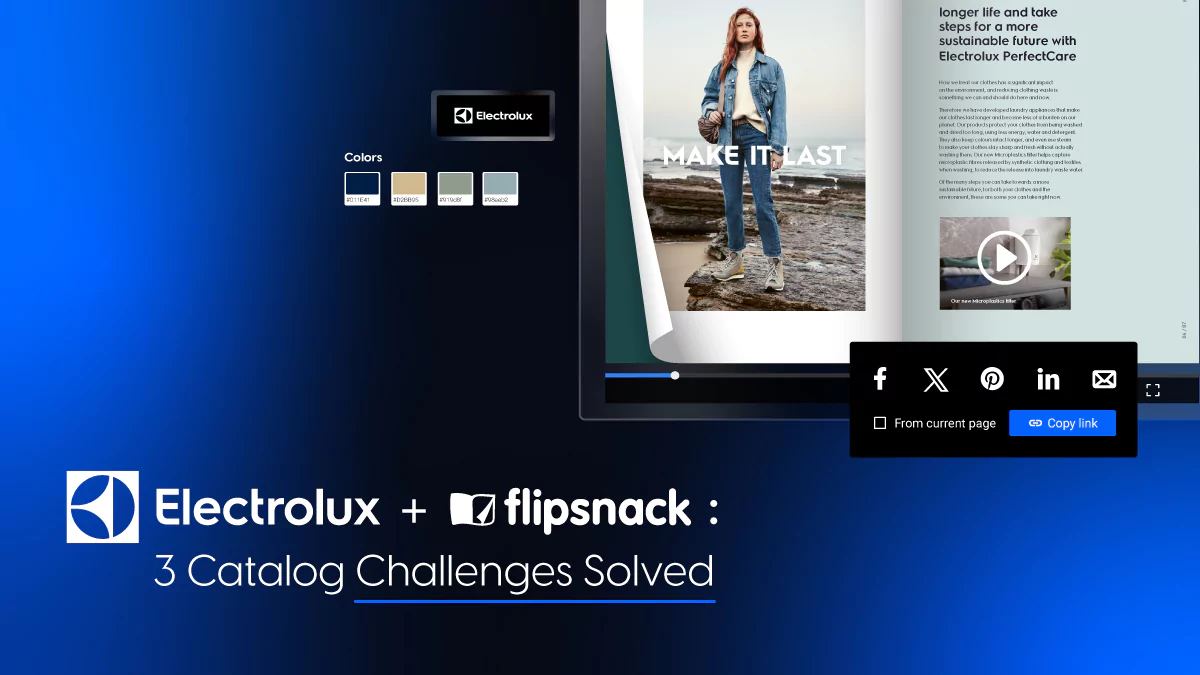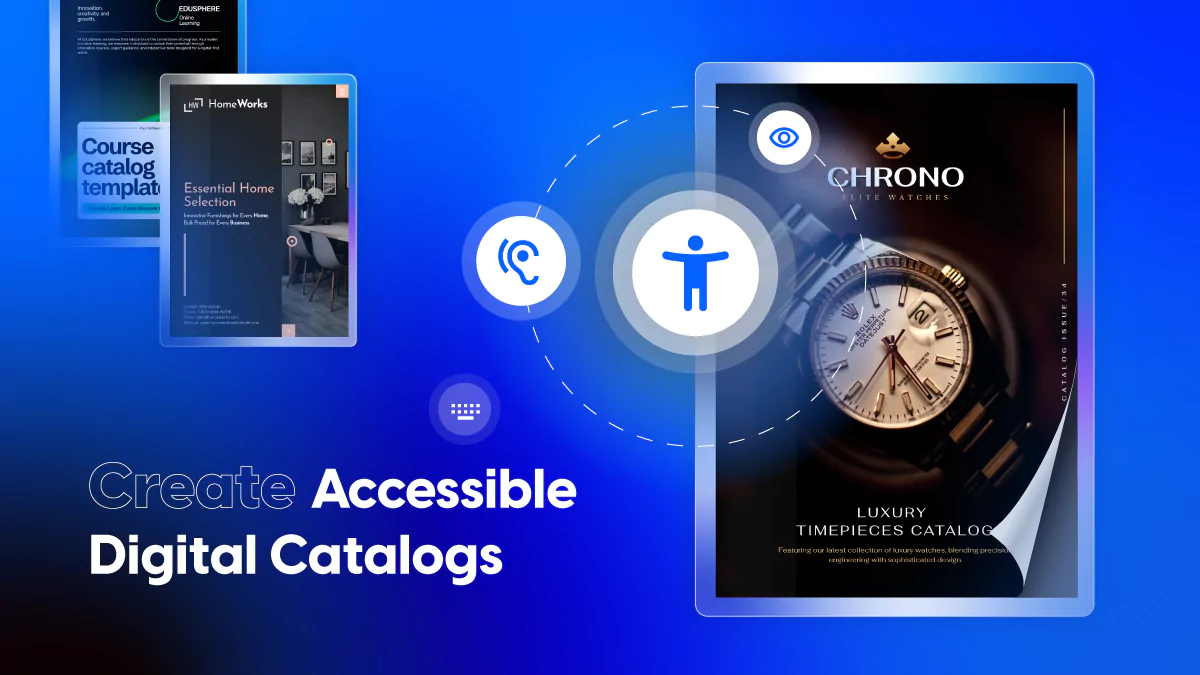Everything you need to know about how to make a catalog online
Last updated: February 27th, 2025
Printed catalogs have long been a staple for wholesalers and retailers, but they come with limitations—static information, high printing costs, and no easy way to update product details. When prices change or new promotions launch, reprinting isn’t a practical solution. However, as e-commerce platforms continuously rise and buying behaviors evolve, digital product catalogs have become valuable marketing assets to most retail and wholesale industry giants.
A digital product catalog solves these challenges by keeping product details, pricing, and promotions up to date automatically. It also enhances the buying experience with interactive features, helping customers make informed decisions with real-time insights. Plus, going digital significantly reduces printing and distribution costs.
In this guide, we’ll walk you through how to create a professional online catalog that keeps your product information current, engages buyers, and ultimately drives more sales.

Table of contents
But first, a quick recap, in case you need it –
What is a digital product catalog?
A digital product catalog is an online version of a product catalog that showcases a company’s products. It can be in different shapes and sizes and is typically accessible through websites, PDFs, or specialized platforms. However, its main goal is to help users interact with product information, such as pricing or material.
Usually, the companies that create digital product catalogs activate mostly online; that’s why it can also be called an e-commerce product catalog.
In the past, product catalogues were only considered to be delivered as printed PDFs. But today, with the help of online catalog makers, B2B and B2C sellers can reach their customers more quickly and cost-effectively.
The entire shopping experience has been dramatically improved since the appearance of digital product catalogues, also known as flipbooks, because of their page-flipping effect.
Customers can grab their laptops, tablets, or smartphones, check their inboxes, and get easy access to the digital catalog in just a few seconds. Moreover, they can immediately purchase products as online product catalogs create shoppable experiences as they have links, buy buttons, price tags, and so much more. We’ll get into that a bit later.
Through an e-catalog, your clients are always just a few clicks away from browsing through its pages and purchasing your products.
What goes into a digital product catalog?
- Front cover
- Table of contents
- Introduction
- Content pages
- Back cover
Now, let’s take them individually and see what details you should keep in mind when learning how to make a product catalog.
1. Front cover
The front cover of any digital product catalog should have an eye-catching design. It’s the first thing your customers see when they receive your email with the digital catalog. And if the front cover doesn’t entice them from the beginning, your audience might lose interest. Cover design mistakes can be costly.
Pick the right products for your front cover and pair them with eye-catching headlines and fun, engaging copy to spark curiosity.
Running a promotion? Highlight it right on the cover and guide readers to the details inside to help drive sales. And don’t forget: professional, high-quality images make a huge difference. If hiring a photographer isn’t an option, try taking photos in natural daylight for bright, stunning results.
Get your audience excited to see what your brand has to offer.
2. Table of contents
Including a table of contents isn’t a must, but it’s a smart move that even big brands still follow, so why shouldn’t you?
The table of contents informs the clients what the product catalog contains, allows them to find the products they’re interested in, and makes browsing easier. For digital catalogs, you can even add clickable buttons to take readers straight to the right page, like in the example below.
Creating a professional product catalog online involves a few key elements, but don’t worry, we’ll walk you through everything you need to know to make one that grabs people’s attention and keeps your audience hooked.
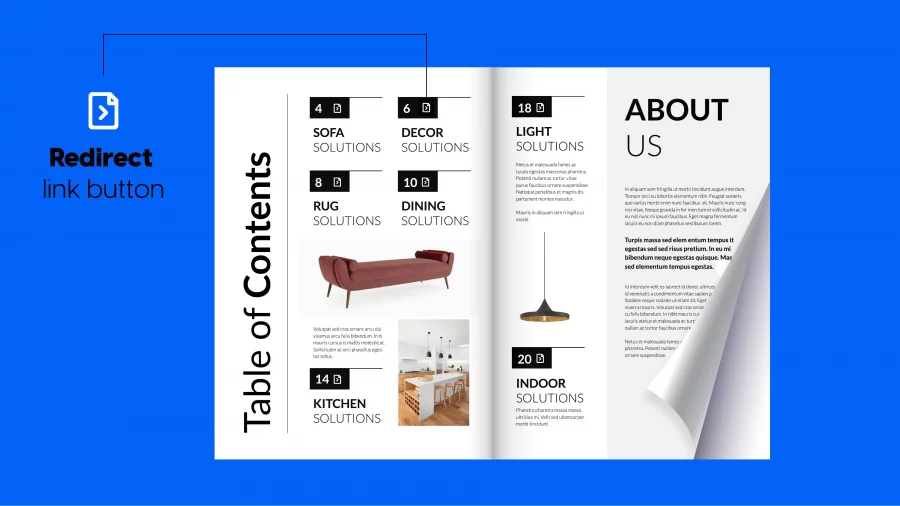
3. Introduction
Just like the previous element, this one is not a must-have, but if you like to give customers a little information about your business, products, or services, here’s your chance. The introduction is usually just a page where the brand can briefly describe the overall product catalog purpose.
For instance, if it’s a promotional edition for the upcoming holidays, then you can mention that in the intro. Stores like cvaley, a fashion and cosmetics brand, use seasonal catalogs to engage their customers with the latest trends and products. If you have items on sale for a limited time, let your customers know that.
Remember that you can also add calls to action and redirect links to the promotion on your website. Doing this provides an easy and accessible shopping experience for your customers.
4. Content pages
The content pages are where your products come to life. Include details like descriptions, images, product videos, prices, and shopping buttons. This is your chance to get creative with colors, fonts, and layouts, but always stay true to your branding.
Your branding kit (logo, colors, typography, etc.) isn’t just for your website or social media. It should shine through in your product catalog, too. A consistent look builds trust and makes your catalog feel professional.
Don’t forget to sprinkle call-to-action buttons throughout the catalog. These guide your customers, encourage purchases, and ultimately boost your sales. And if you’re including videos, try embedding short product demos or testimonials. These are an excellent way to engage and convert your audience.
5. Back cover
The back cover usually has the website link and the brand’s social media platforms. It can also have contact details like email, address, phone number, state, and so on.
Most brands keep this page simple and let the contact details stand out more so that people know how to reach the brand if they need more information.
So there you have it. You only need a few ingredients to make online product catalogues awesome.

And now, let’s see how to make a catalog online using Flipsnack.
How to create an online catalog with Flipsnack
Catalogs have a long history, and while they’ve evolved, they still play a powerful role in shaping the online shopping experience. A well-designed catalog complete with stunning images, engaging product descriptions, and even a touch of humor when appropriate can captivate customers and leave a lasting impression.
Ready to create your own? Let’s dive into the steps for creating an online product catalog that stands out.
1. Define the purpose and target audience
Before creating a product catalog, be clear about its purpose and who it’s for. Is it to attract new customers, assist your sales team, support retail partners, or help product development companies showcase new offerings efficiently? Understanding your audience helps you tailor the catalog’s tone, style, and features to meet their needs.
2. Start the design process from scratch or with a template
Most product catalogs are between 8.5″ x 11″ and 9″ x 12″, or 816 x 1056 to 864 x 1152 pixels. While these are standard sizes, you can adjust them based on your design goals. Catalogs typically range from 4 to 64 pages, depending on the scope of your offerings.
If these technical details feel overwhelming, don’t stress. Flipsnack makes it easy to get started.
You can upload a PDF or use a professional product catalog template. These product catalog templates save time and deliver polished designs, even if you’re not a pro. They ensure elements like balance, colors, and margins, creating a visually appealing and functional catalog.
Templates are the preferred choice nowadays, and it makes sense. Just think about all the WordPress or Wix pages out there. People with no coding experience got the chance to create their websites without turning to a web developer.
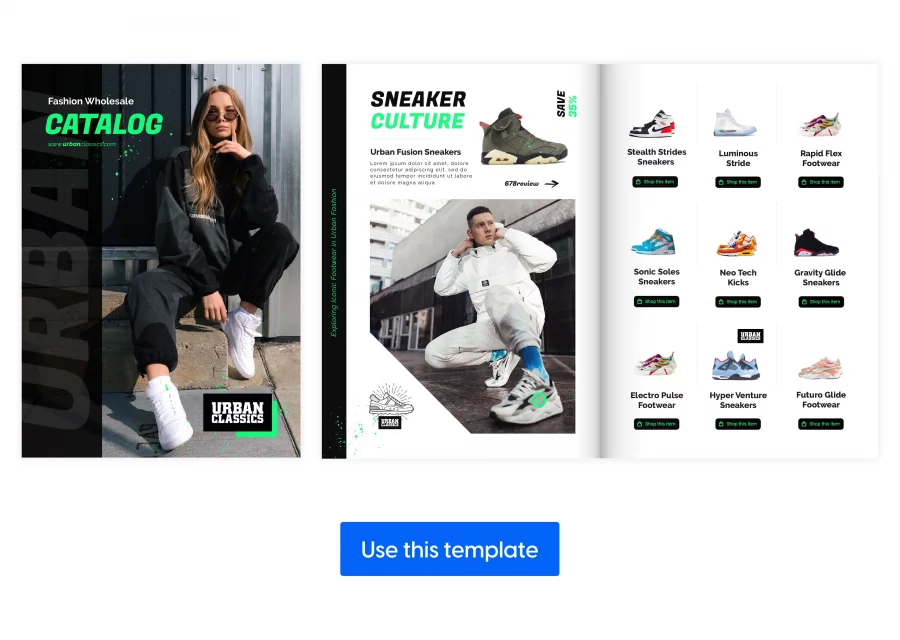
Now, you can notice how much thought is put into creating a template, so when you want to create a product catalog online, you should definitely consider starting with a template. Also, using Flipsnack as a content creation tool means you don’t have to hire a designer to create a product catalog for you.
3. Add professional photos to showcase your products
High-quality photos are non-negotiable. They show your products at their best, set you apart from competitors, and appeal to your audience’s visual instincts. Hire a professional photographer if possible because they’ll know the right lighting, angles, and details to highlight.
💡Tip: Use lifestyle images to show your products in action or in real-world settings. They make a stronger emotional connection than standalone product shots. Just like in the image below.
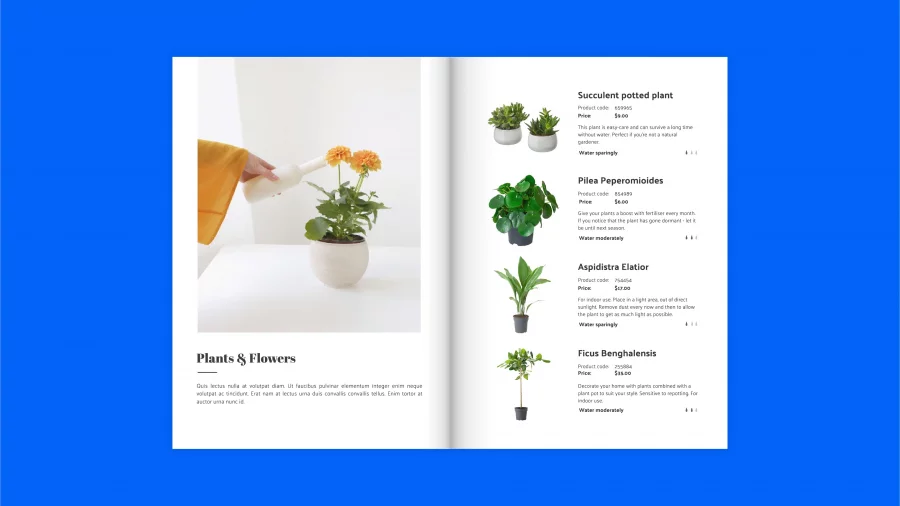
Unsurprisingly, brands invest millions of dollars in commercials because they understand this principle: profits require investing. One of the best investments for your product catalog is to equip it with otherworldly product photography.
4. Write short and concise product descriptions
Pair your stunning photos with compelling, concise product catalog copy. Focus on key details like features, benefits, and unique selling points. Don’t overdo it, as your text should complement the images, not compete with them.
You can get inspired by others who wrote descriptions or use a product descriptions generator, but make sure to edit it and make it your own. For digital catalogs, use product tags to include extra details like prices, discounts, or links to purchase without crowding the page.
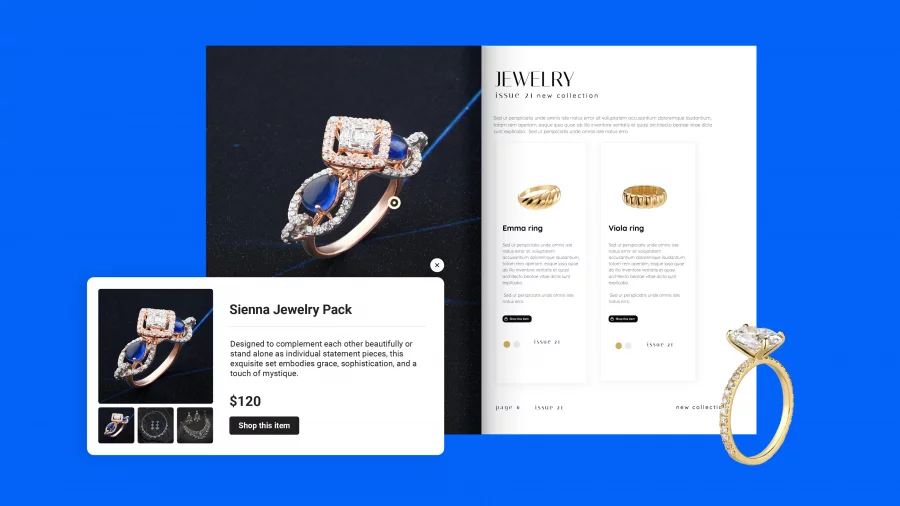
5. Stay true to your branding style
Your catalog is an extension of your brand. So when people flip through your product catalog, they must recognize it’s yours.
This means you need to add your brand identity to product catalogs. Logo, custom fonts, colors, and fullscreen URLs must be considered personal characteristics intended to set you apart.
Recognize that IKEA catalogs from a million? Then you know what I mean.
Respect the brand book guidelines you already have established for your business and let your audience easily recognize your style among your competition. Also, make sure you have brand consistency throughout the entire product catalog design.
💡Tip: Stick to your brand’s color palette and adjust hues or saturation as needed. Avoid cluttering your design with too many colors.
6. Share your digital product catalog
So far, you’ve found out the basics of creating a product catalog; the final step is to make sure as many people as possible get the chance to see it.
You can distribute your catalog in many ways, via direct email, social media, or even embed it on your website. The thing with catalogs is that you want a wide reach. So, take advantage of all the different methods available and reveal your product catalog to everyone.
There are much easier ways to share a PDF document online that are much more engaging and inspirational than downloading every scrollable catalog.
💡Tip: Generate a QR code for your catalog and display it in stores for quick, easy access. You can also create a GIF version to share on social media for added engagement.
Advantages of an online product catalogue
Truth be told, there are many advantages to having an online product catalog. Probably the most important one is that creating a product catalog online is cost-effective. This is extremely helpful for small businesses that otherwise would create product catalogs in programs like Adobe InDesign and pay for hundreds of printed catalog copies.
Let’s see some other benefits of making a catalog for your online products:
- Clicks are cheaper than paper, so making an online product catalog is cost-effective.
- You get the same price no matter the catalog’s size.
- The distribution process is much easier; with a few clicks, you can reach a wider audience through various sharing options across multiple media.
- With the right catalog maker, you can access advanced catalog statistics to analyze your customers’ behavior.
- You get to add interactivity to your product catalogue and help customers get better shopping experiences.
- Instant updates and faster launch times; typos and errors can be fixed without compromising an entire batch of catalogs and without reprinting everything, which would be costly.
- You can add a digital shopping cart, which shortens the buying process.
- Helps sales reps access product details quickly for better conversations and higher conversions.
- It’s mobile-friendly, which means anyone can access it on the go.
And these are only a few benefits of digital catalogs. Let’s not forget how substantially environmentally friendly digital materials are. More and more brands consider this factor when preparing their materials before planning a marketing campaign. Being environmentally conscious is the new must for brands wanting to win their customers’ trust.
When creating a product catalog online, you can showcase the entire product library and make it easily accessible to your customers by adding shopping features that also boost your sales.

If you wonder what those interactive elements are, below is a product catalog example you can flip through and see what a digital catalog looks like:
Real life digital product catalog examples
Electrolux Group is mainly interested in creating and distributing interactive digital catalogues externally to its trade partners. They want to deliver high quality, interactive catalogues to always keep them up to date with their novelties and innovations. In this catalog example you can see how beautifully they integrated videos to showcase their newest products, making this browsing experience much more interesting.
Another company is The Belgian chocolate makers: This company uses product catalogs to sell chocolate by adding links that direct customers to their e-commerce website. This is a great way to make your products more known, and thus increase sales. Include a similar product catalog in a monthly newsletter, or embed it on your website for broader reach.
We finish with this section of real catalog examples by presenting Belwith Keeler, a company creating furniture for every home. “We scout and vet the latest trends from the fashion, furniture, and interior design industries. Inspiration is sourced everywhere, from home, to worlds afar.” They use Flipsnack to showcase their products in a visually appealing, flippable product catalog, and to differentiate themselves from the competitors.
Transform your product catalog into a powerful sales tool
A well-crafted product catalog is more than just a digital showcase—it’s a powerful sales and marketing tool. By keeping product details, pricing, and promotions updated in real time, you provide buyers with the information they need to make confident purchasing decisions. And with interactive features, you create a seamless, engaging shopping experience that drives conversions.
Now is the time to modernize your catalog strategy. Whether you’re a wholesaler, retailer, or manufacturer, transitioning to a digital catalog will help you stay competitive, reduce costs, and streamline your sales process.
Start creating your online product catalog today and give your customers the convenience and insights they expect.

FAQs on how to make a product catalog
Start by defining your catalog’s purpose and target audience. Use a design tool like Flipsnack to create a professional layout, either from scratch or by customizing a template. Add high-quality images, concise product descriptions, and call-to-action buttons. Don’t forget to follow your brand’s style guide for consistency. Once your catalog is ready, share it digitally or in print.
1. Keep it clean: Use a simple, uncluttered layout with plenty of white space to let your products shine.
2. Balance text and visuals: Avoid overwhelming readers with too much text; let high-quality images do the talking.
3. Stick to your branding: Use your brand’s fonts, colors, and logo consistently.
4. Ensure readability: Choose easy-to-read fonts and maintain a clear hierarchy of information.
5. Use professional photography: Highlight your products with high-resolution, well-lit images.
6. Add interactive elements: Include links, shopping buttons, or videos to engage your audience in digital catalogs.
Digital catalog analytics provide insights into customer behavior, like most viewed pages, clicks, and time spent on specific products. Use these statistics to refine your content, rearrange product placements, and prioritize high-performing products. Tools like Flipsnack also allow integration with Google Analytics and Tag Manager for deeper insights into engagement. Adjust designs and calls to action based on these metrics to create more effective catalogs that resonate with your audience.
1. Share your catalog on social media platforms with engaging captions and visuals.
2. Include it in email newsletters or promotional campaigns.
3. Embed it on your website’s homepage or product pages for easy access.
4. Optimize your catalog for SEO to attract organic traffic.
5. Use QR codes on print materials to drive people to your digital catalog.
6. Partner with influencers or other brands to expand your reach.
7. Create short videos or GIFs showcasing your catalog and share them across social media.
1. Use relevant keywords in your catalog titles, descriptions, and metadata.
2. Ensure your catalog is mobile-friendly and loads quickly.
3. Incorporate high-quality images with optimized alt text.
4. Add clickable links to improve navigation and increase time spent on the catalog.
5. Include social sharing buttons to encourage wider distribution.
6. Regularly update your catalog to keep content fresh and appealing to search engines.
Focus on usability and engagement. Use a clean design with clear navigation, add interactive features like shopping buttons, and provide high-quality content with compelling visuals. Share the catalog widely and ensure it’s accessible on multiple devices, including mobile phones and tablets.
You should update your product catalog whenever there are changes to your product offerings, pricing, or promotions. For most businesses, a seasonal update (every 3–4 months) works well, especially if you launch new collections or adjust prices regularly. However, if your business is fast-paced, like fashion or tech, more frequent updates may be necessary. For digital catalogs, updating is quick and cost-effective, so don’t hesitate to refresh content as needed to keep it relevant and engaging for your audience.
